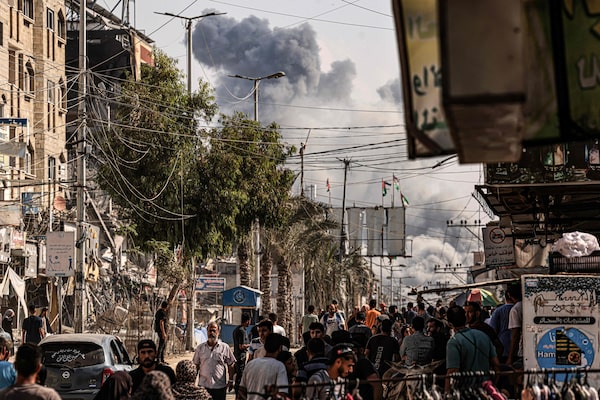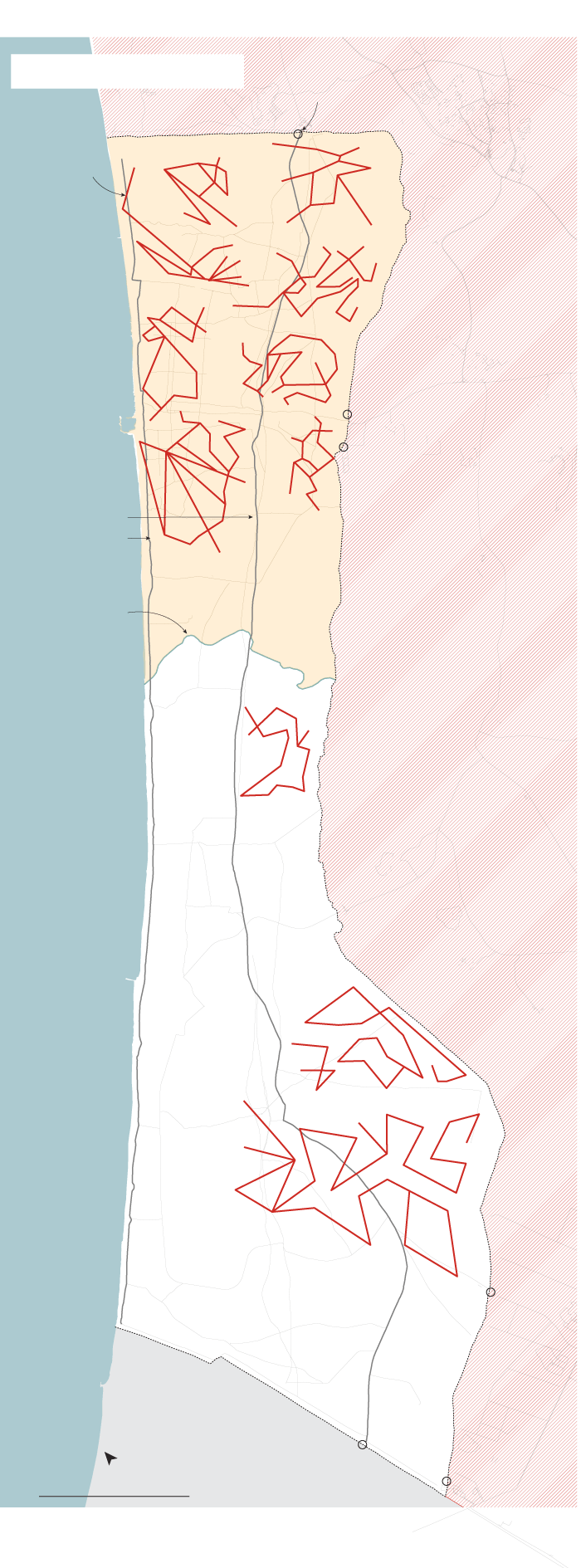
People walk along a street as a plume of smoke rises in the background during an Israeli strike on the Bureij refugee camp in the Gaza Strip, on Nov. 2.MAHMUD HAMS/AFP/Getty Images
An Israeli land force of infantry, tanks and armoured bulldozers has encircled Gaza City, the territory’s major population centre, where untold numbers of Palestinians continue to live in the midst of a raging conflict.
Six days into a major ground invasion of Gaza, Israel now controls much of the northern part of the strip, a key initial achievement that establishes an armed perimeter from which to attack an important centre of Hamas activity.
“We have very impressive successes. We are already on the outskirts of Gaza City,” Prime Minister Benjamin Netanyahu said Thursday.
Thousands have already died in Gaza, including many children and, since the start of their ground operation, at least 18 Israeli soldiers.
Israel’s military, citing operational security, has provided scant information about the ground offensive, saying little about the scale of troops or equipment deployed.
But the contours of Israel’s war strategy are coming into view, with indications that it is a major offensive whose aims presage a lengthy period of deadly fighting and a level of destruction that goes far beyond what has already been inflicted upon the tiny strip – just 365 square kilometres, with a population of more than two million – since the war began on Oct. 7.
“It will take months, maybe more. It’s not a quick war,” said Ilan Lotan, a former officer with the Israeli Security Agency, better known as Shin Bet.
Most of the governing capacity of Hamas is in Gaza City, he said. First, troops will surround the city. “Then you start step by step to kill all Hamas terrorists.”
Latest updates on the Israel-Hamas conflict
One Canadian among first departure of foreign nationals from Gaza Strip, Global Affairs confirms
Israel’s Gazan ground war: A battlefield snapshot
How that proceeds will become clearer in the coming days. Troops with the Israel Defense Forces, or IDF, can advance inward, tightening the circle. But they may prefer to establish a perimeter of control from which special forces and others launch assaults into Gaza City.
“If you go all power in, full-house, a lot of people are going to die from both sides. But if you close the city, and you do some small raids, it’s much better that way,” said a person who works in intelligence for the Israeli army near the border with Gaza. The Globe and Mail is not naming the person because they were not authorized to speak publicly.
“We’re slowly seeing the crystallization of a new security consensus, at least for this war, of rather than this shock and awe offensive, the IDF want more along the lines of a tightening siege on these Palestinian urban areas,” said Rob Geist Pinfold, a lecturer in peace and security at Durham University in Britain.
Such operations carry risks, as Israel has already discovered. Some of the soldiers who died this week were part of an armoured convoy travelling through Gaza that stopped for a group of children playing on the street, said the intelligence specialist, who has direct knowledge of what happened. When troops in the lead vehicle emerged to tell the children to move, they were attacked by militants – a “humanitarian ambush,” the children deliberately placed on the road.
A spokesperson for the IDF did not respond to a request for comment on what took place. The Globe could not independently verify the details of the attack.
In a public statement Thursday morning, Israel’s military spokesperson said troops fought militants overnight, killing dozens and directing air strikes against weapon depots and manufacturing sites.
Ground forces are moving heavy machinery into place and securing their positions, according to a second intelligence specialist for the army. “It will take a few more days just settling, then I think the strikes will start to happen,” said the person, who The Globe is not naming because they were not authorized to speak publicly.
Israel’s ground forces have been able to take control of large parts of northern Gaza’s terrain with comparatively little fighting, according to a second intelligence specialist for the army. Again, The Globe is not naming the person because they were not authorized to speak publicly.
Those forces are moving heavy machinery into place and securing their positions, the person said. “It will take a few more days just settling, then I think the strikes will start to happen.”
Those attacks will bring Israel into a fraught chapter of the war, as soldiers seek to root out militants inside Gaza City, where a dense network of buildings, many still inhabited by civilians, lies over an equally dense maze of tunnels so complex it has been dubbed “the metro.”

Hamas’s tunnels in the Gaza Strip
Zikim
Border crossing
ISRAEL
Sderot
GAZA
STRIP
Closed
military
zone
Tunnels
Gaza
City
Nahal Oz
Main
evacuation
routes
Israeli-
ordered
evacuation
zone
Wadi Gaza
Re’im
Kisufim
Khan Younis
Rafah
EGYPT
North
5 KM
MURAT YÜKSELIR / THE GLOBE AND MAIL, SOURCE: OPENSTREETMAPS; GRAPHIC NEWS; The Humanitarian Data Exchange

Hamas’s tunnels in the Gaza Strip
Zikim
Border crossing
ISRAEL
Sderot
GAZA
STRIP
Closed
military
zone
Tunnels
Gaza
City
Nahal Oz
Main
evacuation
routes
Israeli-
ordered
evacuation
zone
Be’eri
Wadi Gaza
Re’im
Kisufim
Khan Younis
Sufa
Rafah
EGYPT
North
5 KM
MURAT YÜKSELIR / THE GLOBE AND MAIL, SOURCE: OPENSTREETMAPS; GRAPHIC NEWS; The Humanitarian Data Exchange

Hamas’s tunnels in the Gaza Strip
Border crossing
ISRAEL
Sderot
GAZA
STRIP
Tunnels
Closed
military
zone
Gaza City
Nahal Oz
Main
evacuation
routes
Israeli-
ordered
evacuation
zone
Be’eri
Wadi Gaza
Re’im
Kisufim
Khan Younis
Sufa
Rafah
EGYPT
North
5 KM
MURAT YÜKSELIR / THE GLOBE AND MAIL, SOURCE: OPENSTREETMAPS; GRAPHIC NEWS; The Humanitarian Data Exchange
It’s “very dangerous,” said Mr. Lotan, “because you don’t see the enemy most of the time.” A militant in a tunnel can emerge from the ground, fire, then disappear again.
Mr. Lotan was part of a unit that sought to find and destroy tunnels between Gaza and Egypt in 2000.
Today, Hamas tunnels have been built as deep as 70 metres below ground. They are used as weapon depots, living quarters and operational control points. They form one of the chief military challenges in Gaza. Fighting underground is so complex – it has been likened to fighting underwater – that militaries prefer not to send soldiers into tunnels, where the obstacles include booby traps, problems with communications and access to air.
In Gaza, the situation is complicated by the tunnels being widely believed to be where Hamas is holding hostages.
Militaries have fought underground since Roman times. More recently, U.S. forces used B-52 bombers to collapse tunnels in Vietnam and powerful bunker-buster munitions on underground operations in Afghanistan. Russian forces used flame-throwers on tunnels in Syria.
“What states have done in the past is whenever they face these kinds of threats, they deploy their most powerful weapons,” Daphné Richemond Barak, a scholar at Reichman University and the author of Underground Warfare, told the Urban Warfare Project Podcast.
The tunnels in Gaza are interconnected with homes and other buildings – including hospitals, the Israeli military says, although that is disputed by Hamas. That makes them a particular challenge.
Israel’s soldiers have trained for this moment, even constructing a replica “Little Gaza” in the Negev desert.
“People think Israel has now figured it out. Israel has not figured it out,” Prof. Barak said.
Militaries have developed robots and drones to explore tunnels, employed explosives to demolish them, used tear gas pumps to flush people out and even dumped sewage and cement underground.
But Israel’s military has signalled that it is intent on eliminating the tunnels, not just deactivating them, as it has in past wars.
“You have to destroy the tunnels,” Mr. Lotan said. “If you don’t destroy all the tunnels, we got nothing.”
That makes it possible that Israel’s ground forces will not limit operations to northern Gaza, since tunnels also run under southern parts of the strip.
And that calls into question how Israel can complete its objectives in Gaza without laying waste to large parts of the territory’s cities. Air strikes have commonly been the most effective tool for demolishing tunnels, but they also smash what is on the surface – infrastructure and homes.
Where will Gaza’s two million people live if Israel is intent on eliminating all the tunnels?
“You have to ask this question of Hamas,” Mr. Lotan said.